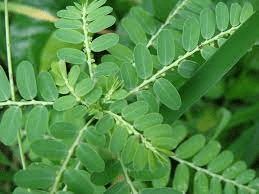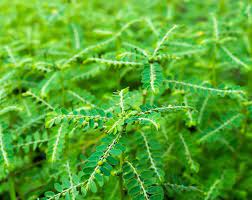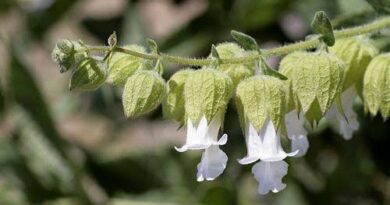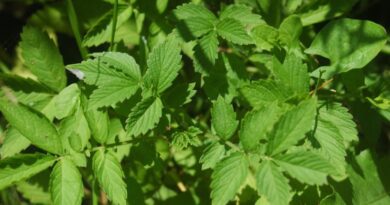17 Medicinal Health Benefits Of Phyllanthus amarus (Stonebreaker)
Phyllanthus amarus, commonly known as Stonebreaker, is a tropical plant belonging to the Phyllanthaceae family. Similar to its relative Phyllanthus niruri (Chanca Piedra), it is recognized for its historical use in traditional medicine, particularly in regions like the Amazon, India, and China. The name “Stonebreaker” reflects its traditional use for the treatment of kidney stones and gallstones.
This herbaceous plant typically grows to a height of 30 to 60 centimeters and has small, greenish flowers. Like Phyllanthus niruri, the entire plant, including leaves, stems, and roots, is utilized for its potential medicinal properties. Phyllanthus amarus contains a variety of bioactive compounds, including alkaloids, flavonoids, lignans, and tannins, which contribute to its therapeutic effects.
In traditional medicine, Stonebreaker has been employed for its diuretic and hepatoprotective properties, and it is often used to support kidney and liver health.
Some studies suggest that it may help prevent the formation of kidney stones by interfering with the crystallization process and promoting the elimination of urinary stones. Additionally, Stonebreaker is investigated for its potential anti-inflammatory and antioxidant activities.
While Stonebreaker is widely used in traditional medicine, it’s important to note that scientific research on its efficacy and safety is still ongoing.
As with any herbal remedy, it is advisable to consult with a healthcare professional before using Phyllanthus amarus for medicinal purposes, especially if you have existing health conditions or are taking other medications.
The Botanical Description of Phyllanthus amarus
1. Plant Structure: Phyllanthus amarus, commonly known as “stonebreaker,” is a tropical plant characterized by its small stature, typically growing up to 50 centimeters in height. The plant features slender stems and delicate, green, oblong leaves.
2. Leaves: The leaves of Phyllanthus amarus are arranged alternately along the stems. They are small, about 5 to 10 millimeters in length, and possess a smooth texture.
3. Flowers: The plant produces inconspicuous flowers that are either male or female, and sometimes both on the same plant. The flowers are typically greenish-yellow in color and are arranged in clusters.
4. Fruit: Phyllanthus amarus bears small, round fruits, usually around 3 millimeters in diameter. The fruits contain seeds and have a slightly fleshy texture.
5. Root System: The plant has a well-developed root system that aids in its adaptation to various soil types. The roots are not overly extensive, contributing to the plant’s relatively compact size.
6. Growth Habitat: Phyllanthus amarus is often found in a variety of habitats, including open fields, wastelands, and along riverbanks. It is known for its resilience and ability to thrive in diverse environments.
7. Overall Appearance: The overall appearance of Phyllanthus amarus is that of a delicate, yet hardy, herbaceous plant. Its unassuming stature belies its potent medicinal properties.
8. Seasonal Changes: The plant may exhibit variations in appearance based on seasonal changes. During certain periods, it may display increased growth and flowering, while in other seasons, it might focus energy on seed production.
9. Adaptability: Phyllanthus amarus has demonstrated adaptability to different climates, making it a versatile botanical species found in various parts of the world.
10. Aromatic Qualities: Some varieties of Phyllanthus amarus are known for their subtle aromatic qualities, contributing to the sensory experience associated with the plant.
The Geographic Distribution of Phyllanthus amarus

1. Native Regions: Phyllanthus amarus is native to tropical regions, including parts of Central and South America, Africa, and Southeast Asia.
2. Global Spread: Due to its adaptability and medicinal significance, Phyllanthus amarus has been introduced to various tropical and subtropical regions around the world. It is now found in countries with suitable climates.
3. Presence in Asia: The plant is commonly found in countries such as India, China, and Thailand, thriving in the warm and humid conditions prevalent in these regions.
4. South American Habitat: In South America, Phyllanthus amarus is distributed across countries like Brazil, Peru, and Colombia. It often grows along riverbanks and in areas with adequate moisture.
5. African Regions: The plant has a presence in African countries, including Nigeria, Ghana, and Kenya. It is adapted to diverse ecosystems within the continent.
6. Caribbean Islands: Phyllanthus amarus has also been reported in certain Caribbean islands, where it has become established in suitable environments.
7. Southeast Asian Growth: The plant is well-suited to the climates of Southeast Asian countries, where it is found in regions like Indonesia, Malaysia, and the Philippines.
8. Favorable Conditions: Phyllanthus amarus thrives in areas with well-drained soil, ample sunlight, and consistent moisture. It often colonizes disturbed habitats and can be found in both rural and urban settings.
9. Human-Induced Spread: The plant’s medicinal properties, coupled with its adaptability, have led to its intentional cultivation and, at times, unintentional spread by human activities.
10. Conservation Status: Phyllanthus amarus is not listed as endangered or threatened. Its ability to grow in diverse conditions contributes to its widespread presence.
11. Environmental Impact: While the plant is valued for its medicinal uses, its introduction to new areas can have ecological implications. Care should be taken to prevent invasive tendencies in non-native habitats.
12. Research and Documentation: Ongoing research and documentation contribute to a better understanding of the geographic distribution of Phyllanthus amarus, aiding in conservation efforts and sustainable use.
The Chemical Composition of Phyllanthus amarus
1. Phyllanthin: Phyllanthus amarus contains phyllanthin, a bioactive compound with demonstrated hepatoprotective properties. It is associated with liver health support.
2. Hypophyllanthin: Another important lignan present in Phyllanthus amarus, hypophyllanthin, contributes to the plant’s therapeutic effects, including potential antiviral properties.
3. Niranthin: Niranthin is a key alkaloid found in the plant, known for its anti-inflammatory and antioxidant activities. It adds to the overall medicinal profile of Phyllanthus amarus.
4. Geraniin: Geraniin, a tannin present in the plant, exhibits antioxidant and anti-inflammatory properties. It contributes to the plant’s overall health-promoting effects.
5. Ellagic Acid: Ellagic acid, a polyphenol, is present in Phyllanthus amarus and is associated with antioxidant and anticancer activities.
6. Quercetin: The plant contains quercetin, a flavonoid known for its anti-inflammatory and antiviral effects. It contributes to the diverse chemical composition of Phyllanthus amarus.
7. Beta-Carotene: Phyllanthus amarus is a source of beta-carotene, a precursor to vitamin A, providing nutritional value.
8. Gallic Acid: Gallic acid, a polyphenol found in the plant, contributes to its antioxidant and anti-inflammatory properties.
9. Corilagin: Corilagin, a tannin present in Phyllanthus amarus, has demonstrated antiviral and anti-inflammatory activities.
10. Essential Oils: Some varieties of Phyllanthus amarus may contain essential oils, contributing to the plant’s aromatic properties.
11. Corrosolic Acid: Corrosolic acid, found in the leaves of the plant, has been studied for its potential antidiabetic properties.
12. Ursolic Acid: Ursolic acid, present in Phyllanthus amarus, exhibits anti-inflammatory and antimicrobial properties.
13. Isoquercetin: Isoquercetin, a flavonoid, is part of the plant’s chemical composition, adding to its antioxidant and anti-inflammatory effects.
14. Flavonols: Various flavonols, including kaempferol and myricetin, contribute to the overall antioxidant capacity of Phyllanthus amarus.
15. Polyphenolic Compounds: The plant is rich in polyphenolic compounds, collectively contributing to its medicinal and health-promoting properties.
Read Also: Best Blueberry Varieties for Home Gardens
The Medicinal Health Benefits Of Phyllanthus amarus (Stonebreaker)

1. Liver Health Support: Phyllanthus amarus is renowned for its hepatoprotective properties, supporting liver health and aiding in the treatment of liver disorders.
2. Kidney Stone Prevention: The plant has been traditionally used to prevent and manage kidney stones, with scientific studies supporting its antilithiatic effects.
3. Antiviral Activity: Phyllanthus amarus exhibits antiviral properties, making it potentially beneficial in the management of viral infections, including hepatitis B.
4. Anti-Inflammatory Effects: The plant’s anti-inflammatory properties contribute to its use in managing inflammatory conditions, providing relief from discomfort.
5. Antioxidant Support: Rich in antioxidants, Phyllanthus amarus helps combat oxidative stress, protecting cells from damage caused by free radicals.
6. Diuretic Properties: The diuretic effects of the plant may aid in promoting kidney health and regulating fluid balance within the body.
7. Antidiabetic Potential: Some compounds found in Phyllanthus amarus, such as corosolic acid, show potential in managing blood sugar levels, making it relevant for individuals with diabetes.
8. Gastrointestinal Health: The plant has been traditionally used to support digestive health, with reported benefits for conditions such as gastritis and dyspepsia.
9. Immunomodulatory Effects: Phyllanthus amarus may modulate the immune system, enhancing the body’s defense mechanisms against infections.
10. Anticancer Properties: Preliminary studies suggest potential anticancer properties, paving the way for further research into the plant’s role in cancer prevention and treatment.
11. Cardiovascular Health: The antioxidant and anti-inflammatory effects of Phyllanthus amarus contribute to cardiovascular health, supporting overall heart function.
12. Antimicrobial Actions: The plant exhibits antimicrobial properties, making it valuable in addressing various infections caused by bacteria or fungi.
13. Respiratory Health: Phyllanthus amarus may have benefits for respiratory health, potentially assisting in the management of conditions like asthma and bronchitis.
14. Antipyretic Effects: Traditionally, the plant has been used to reduce fever, highlighting its antipyretic properties.
15. Skin Conditions: External application or topical formulations of Phyllanthus amarus may have benefits for certain skin conditions, including eczema and rashes.
16. Anti-Ulcer Effects: Some studies suggest that the plant may have protective effects against gastric ulcers, contributing to gastrointestinal health.
17. Antispasmodic Actions: Phyllanthus amarus has been employed traditionally as an antispasmodic agent, providing relief from muscle spasms and cramps.
The Methods of Usage to Achieve the Provided Health Benefits Of Phyllanthus amarus (Stonebreaker)
1. Herbal Infusions: Prepare herbal infusions by steeping dried Phyllanthus amarus leaves in hot water. This method is suitable for obtaining the plant’s benefits for digestion, kidney health, and overall well-being.
2. Tinctures and Extracts: Tinctures and liquid extracts of Phyllanthus amarus are convenient for precise dosage. They are suitable for individuals who prefer concentrated forms of the herb for liver support and antiviral benefits.
3. Capsules and Tablets: Phyllanthus amarus supplements in capsule or tablet form provide a measured and convenient way to incorporate the herb into a daily routine. This method is ideal for those seeking kidney stone prevention and immune system support.
4. Powdered Form: The dried leaves of Phyllanthus amarus can be ground into a powder, offering versatility in consumption. The powder can be added to smoothies, juices, or incorporated into culinary recipes.
5. Herbal Teas: Brewing Phyllanthus amarus leaves into a tea is a traditional and soothing method of consumption. This is particularly beneficial for those seeking relief from respiratory issues and fever reduction.
6. Topical Applications: For skin conditions, a paste or salve made from crushed Phyllanthus amarus leaves can be applied topically. This method may help alleviate symptoms of eczema, rashes, and other skin conditions.
7. Culinary Uses: Incorporate Phyllanthus amarus into culinary creations by adding fresh leaves to salads or using them as a garnish. This provides a subtle way to include the herb in daily meals.
8. Complementary Formulas: Combine Phyllanthus amarus with other complementary herbs for synergistic effects. This approach is common in traditional herbal formulations designed to address specific health concerns.
9. Periodic Detoxification: Integrate Phyllanthus amarus into periodic detoxification routines to support liver health and assist in the removal of toxins from the body.
10. Rotation in Usage: Some individuals may opt for a cyclical approach, using Phyllanthus amarus for a specific duration and then taking breaks. This allows the body to adapt and prevents tolerance.
11. Combination with Lifestyle Changes: Achieve optimal health benefits by complementing Phyllanthus amarus usage with positive lifestyle changes. This includes maintaining a balanced diet, staying hydrated, and engaging in regular physical activity.
12. Customized Dosage: Adjust the dosage of Phyllanthus amarus based on individual factors such as age, health condition, and response. Customization allows for a tailored approach to herbal supplementation.
The Side Effects Of Using Phyllanthus amarus Medicinal Plant
1. Digestive Discomfort: Some individuals may experience mild digestive discomfort, including nausea or upset stomach, especially when using higher doses. Adjusting the dosage or discontinuing use can alleviate these effects.
2. Allergic Reactions: Individuals with known allergies to Phyllanthus amarus or related plants may experience itching, rash, or swelling. Discontinue use and seek medical attention if allergic reactions occur.
3. Interaction with Medications: Phyllanthus amarus may interact with certain medications. Individuals taking prescription drugs, especially for liver conditions or viral infections, should consult healthcare professionals before use.
4. Pregnancy and Breastfeeding: Pregnant or breastfeeding individuals should exercise caution and seek guidance from healthcare providers before using Phyllanthus amarus, as limited information is available regarding its safety during pregnancy and breastfeeding.
5. Blood Sugar Levels: Individuals with diabetes or those on medications to regulate blood sugar levels should monitor their levels closely while using Phyllanthus amarus, as it may affect blood glucose.
6. Blood Pressure: Phyllanthus amarus has been associated with potential blood pressure-lowering effects. Individuals with hypertension should monitor their blood pressure regularly and consult with healthcare professionals.
7. Diuretic Effects: The diuretic properties of Phyllanthus amarus may lead to increased urination. Individuals with kidney issues or those on medications affecting fluid balance should use the herb cautiously.
8. Hormonal Impact: Some compounds in Phyllanthus amarus may influence hormonal balance. Individuals with hormonal disorders or those undergoing hormonal therapies should seek professional advice.
9. Impact on Platelets: The plant may have mild antiplatelet effects. Individuals taking anticoagulant or antiplatelet medications should consult healthcare providers before using Phyllanthus amarus.
10. Gastrointestinal Upset: In some cases, the use of Phyllanthus amarus may lead to gastrointestinal upset, including diarrhea or bloating. Adjusting the dosage or discontinuation can alleviate these effects.
11. Potential Interaction with Herbs: Combining Phyllanthus amarus with other herbal supplements may have unforeseen interactions. Consult with healthcare professionals, especially if using multiple herbal remedies simultaneously.
12. Impact on Blood Sugar Levels: Individuals with diabetes or those on medications to regulate blood sugar levels should monitor their levels closely while using Phyllanthus amarus, as it may affect blood glucose.
13. Photosensitivity: Some individuals may experience increased sensitivity to sunlight while using Phyllanthus amarus. It is advisable to take precautions, such as using sunscreen, to prevent sun-related skin issues.
14. Impact on Fertility: Limited research suggests potential effects on fertility. Couples trying to conceive should seek guidance from healthcare professionals before incorporating Phyllanthus amarus into their routine.
Understanding the potential side effects of Phyllanthus amarus is crucial for informed and safe usage. It is recommended to consult with healthcare professionals, especially for individuals with pre-existing health conditions or those taking medications.
Read Also: How to Freeze Blueberries
The Scientific Research and Studies of Phyllanthus amarus

1. Hepatoprotective Effects: Numerous studies have explored the hepatoprotective properties of Phyllanthus amarus, demonstrating its potential in mitigating liver damage and supporting liver health.
2. Antiviral Activity: Research indicates that Phyllanthus amarus exhibits antiviral effects, particularly against the hepatitis B virus. This has led to its traditional use in managing viral infections.
3. Antioxidant Properties: The plant’s antioxidant properties have been investigated, revealing its ability to neutralize free radicals and reduce oxidative stress, contributing to overall health.
4. Antilithiatic Effects: Scientific studies support the traditional use of Phyllanthus amarus in preventing and treating kidney stones, showcasing its antilithiatic effects.
5. Anti-Inflammatory Actions: The anti-inflammatory properties of Phyllanthus amarus have been documented, suggesting its potential in managing inflammatory conditions and providing relief from related symptoms.
6. Antidiabetic Potential: Certain compounds in Phyllanthus amarus, such as corosolic acid, have been studied for their potential in managing blood sugar levels, indicating its relevance for individuals with diabetes.
7. Immunomodulatory Effects: Research suggests that Phyllanthus amarus may modulate the immune system, enhancing the body’s ability to defend against infections and diseases.
8. Anticancer Properties: Preliminary studies have explored the plant’s potential anticancer properties, with some promising results indicating its role in cancer prevention and treatment.
The Safety Precautions and Recommendations In Using Phyllanthus amarus Medicinal Plant
1. Consultation with Healthcare Professionals: Before incorporating Phyllanthus amarus into your health routine, especially if you have pre-existing health conditions or are taking medications, consult with healthcare professionals for personalized advice.
2. Monitoring Liver Function: Individuals with liver conditions or those undergoing treatment should monitor their liver function regularly while using Phyllanthus amarus. Healthcare providers can assist in appropriate assessments.
3. Dosage Guidance: Adhere to recommended dosage guidelines provided by healthcare professionals or product labels. Avoid excessive intake to prevent potential side effects.
4. Pregnancy and Breastfeeding: Pregnant and breastfeeding individuals should exercise caution and seek professional advice before using Phyllanthus amarus due to limited information on its safety during these periods.
5. Blood Pressure Monitoring: Regularly monitor blood pressure, especially if you have hypertension, as Phyllanthus amarus may influence blood pressure levels.
6. Periodic Health Check-ups: Incorporate regular health check-ups to track any changes or developments related to Phyllanthus amarus usage. Keep healthcare providers informed about herbal supplements you are taking.
7. Discontinuation in Case of Side Effects: If you experience any unexpected side effects while using Phyllanthus amarus, discontinue use and seek medical advice promptly.
8. Inclusion in a Holistic Approach: Integrate the use of Phyllanthus amarus into a holistic approach to health, including a balanced diet, regular exercise, and other wellness practices for comprehensive well-being.
9. Awareness of Allergies: Be aware of any allergies to Phyllanthus amarus or related plants. If allergic reactions occur, discontinue use and seek immediate medical attention.
10. Interaction with Medications: If you are taking prescription medications, consult with healthcare professionals to ensure that Phyllanthus amarus does not interact adversely with your medications.
11. Photosensitivity Precautions: Due to potential photosensitivity, take precautions such as using sunscreen to avoid skin-related issues during exposure to sunlight.
12. Fertility Considerations: Couples trying to conceive should be cautious, considering potential effects on fertility. Seek guidance from healthcare professionals if planning for pregnancy.
13. Individualized Approach: Each individual may respond differently to Phyllanthus amarus. Consideration of individual health conditions and responses is essential for a personalized and effective approach.
14. Mental Health Considerations: While limited research suggests potential cognitive benefits, individuals with mental health concerns should consult with healthcare professionals for personalized advice.
15. Age Considerations: While there are no strict age restrictions, it is advisable to consult with healthcare professionals, especially for children, pregnant women, and the elderly, to ensure safe and appropriate usage.
FAQs About Phyllanthus amarus Medicinal Plant
1. Is Phyllanthus amarus safe for long-term use?
Phyllanthus amarus is generally considered safe for long-term use when used within recommended dosage guidelines. However, individual responses may vary, and periodic health check-ups are advisable.
2. Can Phyllanthus amarus be used during pregnancy?
Pregnant individuals should exercise caution, and consultation with healthcare professionals is recommended due to limited information on the safety of Phyllanthus amarus during pregnancy.
3. What is the recommended dosage for Phyllanthus amarus supplements?
Dosage recommendations may vary based on the form of the supplement (capsules, extracts, teas). Follow product labels or healthcare professional guidance for appropriate dosage.
4. Does Phyllanthus amarus interact with medications?
Phyllanthus amarus may interact with certain medications, especially those affecting the liver or blood clotting. Consult with healthcare professionals if you are taking prescription drugs.
5. How does Phyllanthus amarus support liver health?
Phyllanthus amarus has hepatoprotective properties, supporting liver health by mitigating damage and promoting liver function. Regular use is associated with liver health benefits.
6. Can Phyllanthus amarus prevent kidney stones?
Answer: Yes, scientific studies support the traditional use of Phyllanthus amarus in preventing and managing kidney stones, showcasing its antilithiatic effects.
7. Are there any age restrictions for using Phyllanthus amarus?
While there are no strict age restrictions, it is advisable to consult with healthcare professionals, especially for children, pregnant women, and the elderly, to ensure safe and appropriate usage.
8. What precautions should be taken for individuals with diabetes using Phyllanthus amarus?
Individuals with diabetes should monitor their blood sugar levels closely while using Phyllanthus amarus, as it may influence blood glucose. Regular healthcare professional consultations are advisable.
9. Does Phyllanthus amarus have any cognitive benefits?
Limited research suggests potential cognitive benefits. Individuals with mental health concerns should consult with healthcare professionals for personalized advice.
10. Can Phyllanthus amarus be used topically for skin conditions?
Yes, a paste or salve made from crushed Phyllanthus amarus leaves can be applied topically for certain skin conditions, providing relief from symptoms.
Read Also: How to Choose the Right Trash Service for Your Needs









